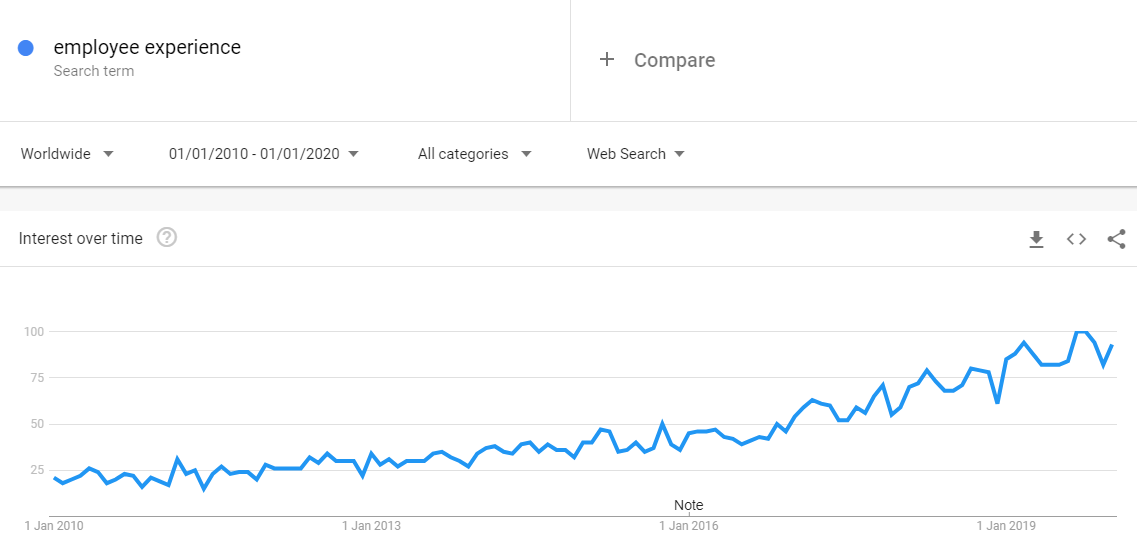
Employee Experience (EX) is a hot topic.
In LinkedIn’s Global Talent Trends Report, EX is ranked as the top priority. Numerous articles and books (including my own) have been written about it. Most consulting firms have EX white papers you can download. EX conferences are springing up. People are already complaining that it’s the latest HR buzzword. Some wonder if it’s a fad; about to peak in the hype cycle.
Here’s the obligatory google search term graph:

I think EX is much more than a fad.
It is becoming more important because of some solid reasons, which I have written about here. It’s the result of forces like digital transformation, the rise of social media, and the desire for greater transparency. These are long-term changes that mean EX will remain a priority in the future.
I do think it’s important to be clear on what we mean by EX, though. There’s a danger that is becomes a “catch-all” phrase.
There are three EX definitions that I use, which I have summarised below. The first is quite simple, but it gets at an important change in perspective. The second is about the field or discipline of EX (in which I work). The third is more technical, but it’s the one that I use the most. This definition gets at the importance of new sources of data and new types of analytics, which for me at least, is key.
Here they are:
Definition 1: “Employee experience can be thought of as simply “What’s it like to work here?” From the run up to your first day, to the end of your first month, to your first anniversary, to a promotion, and so on, until you leave.”
I like this definition because it gets at a change in perspective, which can be hard for people to get their head around. I explain this by contrasting EX with traditional approaches to employee engagement. Employee engagement is usually a top-down process that is management-led. It’s about alignment, coordination and resources. For this reason, engagement fits easily within a traditional management mindset. By contrast, I think EX is bottom-up and messy, and it’s employee-centred. It’s about capturing individual points of view, which makes it personal and conversational. EX requires a different leadership style.
Definition 2: “EX is a new, emerging science that uses new sources of data and new analytics, and we are only at the beginning.”
I feel this is an important point to make, because although EX builds on previous work on employee satisfaction, morale, climate, commitment and engagement, it’s also something new. EX is enabled by new technology, new sources of data and new analytics. As a result, you need different approaches and tools to analyse EX and make sense of it. I honestly think we’re only at the start of developing these. New cognitive machine technologies and new sources of flowing data are going to revolutionise the field in the years ahead. That’s exciting to think about.
Definition 3: “Employee experience is about analysing individual journeys together and dynamically, so you can understand and improve events, touch points and processes in order to gain a systemic lift in productivity and performance.”
As I said, this is the definition that I use most, even though it’s a mouthful. The point here is that organisations are now able to look at experiences over time and to map and analyse specific journeys. This is because of new sources of data that come from more continuous listening (active and passive). You can also organise those insights in non-traditional ways, such as for cohorts and personas rather than departments and demographics. I firmly believe that lots of small changes can add up to something transformational. This idea is a key plank of design thinking. Of course, the link to business challenges, especially mission-critical ones like collaboration and innovation remains key.
I hope you find these definitions useful. Let me know what you think. I realise there are lots of different ways of looking at EX.
You can read more about how companies are focusing on EX here as well as by following me on LinkedIn and twitter.
Tags: #EmployeeExperience
This article was first published on Medium on February 5, 2020.